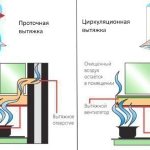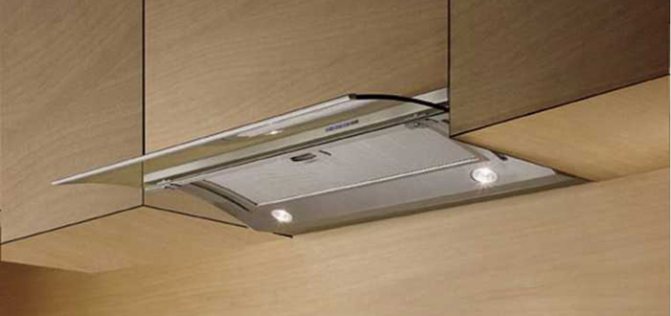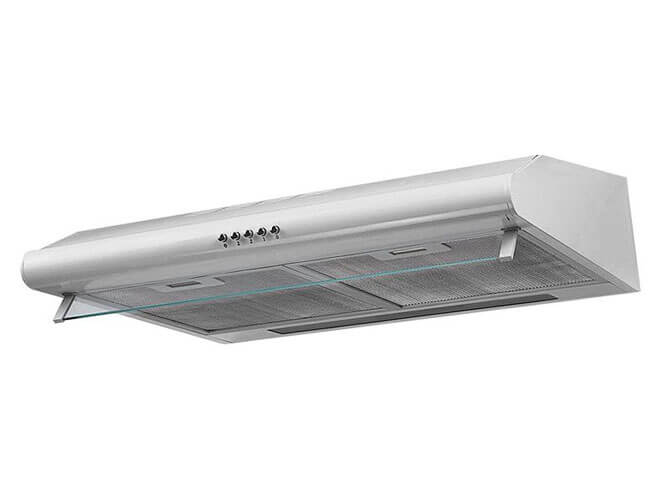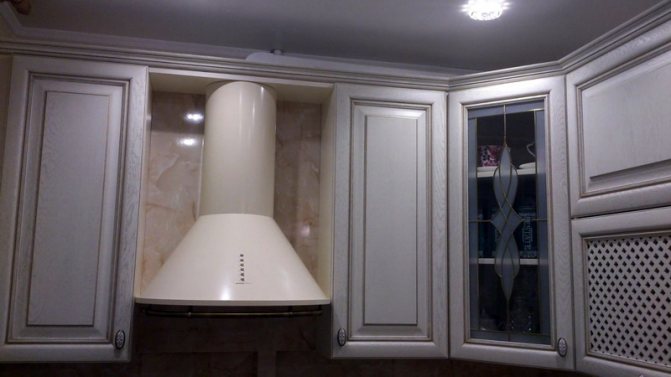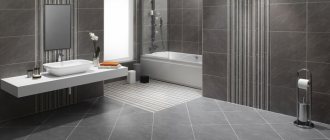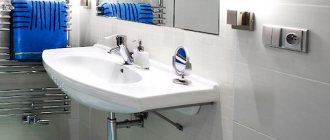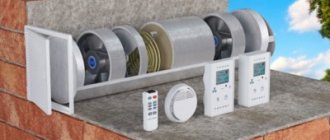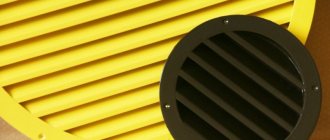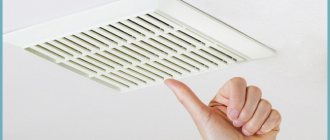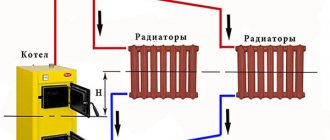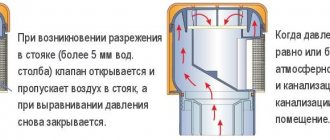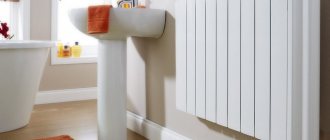In principle, each hood resembles a vacuum cleaner (in principle of operation), but performs different tasks. The power of the vacuum cleaner is infinitely adjustable, allowing you to select the desired mode. The kitchen hood has a stepped circuit, when the speeds change without a smooth transition, the electrical circuit is different. Triacs are often used for smooth regulation, a jump change is easier to produce by switching the windings. Regardless of the hood device, in both cases amplitude control is applicable, therefore we do not exclude the existence of circuits on thyristor switches or inverter control. In the latter case, the hood device in the kitchen will cost a pretty penny.
Exhaust equipment and its device
A household hood is a specialized device that cleans the air from impurities, smoke, unpleasant odors emitted during the heat treatment of food. The design of this apparatus consists of several parts, such as a housing, a ventilation unit, filters for collecting grease, and a control panel. Grease filters protect the motor and the inside of the equipment from the accumulation of fatty deposits.
All components of this equipment are made of materials that are resistant to rust and temperature extremes. The body of the device is made of stainless steel as standard. The modern model, in addition to the function of air purification, can at the same time be a decoration of the kitchen, it also plays the role of a design object. Therefore, in addition to stainless steel, glass, wood, ceramics are used for the manufacture of the case, and the hood is decorated with various decor.
How household hoods work
There are several types of cooker hoods. The principle of operation is the main criterion for distinguishing between models. Each type has its own advantages and disadvantages. Types of equipment according to the principle of operation:
- flow-through type;
- circulation type;
- mixed.

The principle of operation of the flow and circulation hood
The flow model is connected to the general ventilation system of the house. It is equipped with an air duct through which the polluted air goes to the general ventilation. Clean air enters the kitchen from other rooms or from open windows.
The circulating hood is not connected to the ventilation system by the duct. Air contaminated with vapors and odors is cleaned in the filter system and then returned to the kitchen. How does a kitchen hood with a circulating mechanism work? It has an air collector with a filter system, which receives the polluted air from the kitchen.
Also, this type of hood is equipped with a powerful motor for greater efficiency. Circulating hoods are well suited for kitchens where the ventilation duct is removed from the stove. They can be installed in older houses with poor ventilation. Typically, the circulating hood is equipped with activated carbon filters, which must be changed periodically.
Mixed hoods have an air duct and a filter system. They work both in the circulation and in the flow mechanism. In winter, you can set the circulation type of work in order to keep the warmth in the apartment. To make a mixed flowing unit, a filter system is installed inside.
The flow-through hood has one significant drawback. When turned off, it interferes with the natural circulation of air in the kitchen, because it closes the ventilation.
This necessitates leaving windows open. The circulating hood is devoid of this drawback. But it also has its drawbacks.The circulating cooker hood is very noisy. This is due to the increased power of the motor. The price of filters for circulating hoods is high, and they need to be changed regularly.
Pros and cons of forced draft
Forced exhaust system implies the installation of one or more fans in the room instead of standard grilles... During operation, they contribute to the flow of clean air from the duct and remove unpleasant odors, harmful substances, moisture and dust from the room.
The mechanical system allows you to purify the air in the room with greater efficiency. Many fans of this type can be adjusted by independently changing the power and rotation speed.


The advantages of installing forced draft include:
- the possibility of faster air purification in the room;
- long service life and high-quality functioning regardless of the peculiarities of weather conditions or the condition of the ventilation pipes;
- possibility self-regulating air outflow and inflow.
Insofar as fans of this type work automatically, when you turn off the electricity in the house, you will not be able to provide proper ventilation of the room. In addition, forced-type fans can be quite expensive, taking into account the need to set up equipment and conduct the network.
Periodically, parts of such a system, as well as filters, will have to be replaced with new ones, and it is not always possible to notice problems in time.
There are several variations of forced ventilation of houses and apartments, so before deciding on a purchase, study in detail the features of their work.
Selection parameters for the cooker hood
Installing exhaust equipment in the kitchen is a necessary and moderately difficult task. Before buying an air purifier, familiarize yourself with the main criteria for choosing a model, you need to know the principle of the hood operation. The hood design plays an important role:
- the mechanism of the air cleaner;
- type of hood installation;
- hood size parameters;
- the efficiency of the hood;
- material from which the hood is made;
- the noise level of the hood operation.
With the principle of operation of the kitchen hood, everything is already clear. Let's dwell on other parameters in more detail.
Connection in the apartment
When installing a forced draft hood in the kitchen think over the way to supply power into such a system. There are two effective ways: in the first case, the connection is made directly to the power box, in the second - the system is powered through the socket.
If you settled on the first option, plan the main work in advance. Only after the necessary communications have been carried out, you can proceed to fixing the system and choosing the exhaust mechanisms.
Installation of equipment will not cause you any special difficulties: fans of this type are quite compact, like all accompanying elements, and you can, if necessary, learn more about the consultants about the features of their fastening. As a rule, the grill with the fan is fixed to the wall with screws.


To install a forced draft hood in the bathroom, it is necessary to mount a grill with a fan in the exhaust hole. It is already in the room, so you don't have to make additional holes in the wall. Power supply must be connected to the fan mounting area. Most fans are standard sizes, but in any case, make sure that the area of the hole in the wall does not have to be adjusted to the parameters of such a design.
Since ventilation equipment designed for the bathroom must work efficiently even in humid conditions, choose the right model carefully. Fans with special IPx4 marking are suitable for you.Experts recommend choosing equipment with check valves so that polluted air or unpleasant odors from the kitchen and other areas do not enter the bathroom.
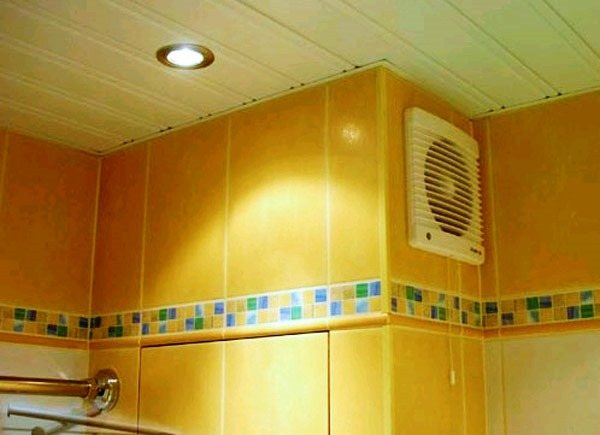

Installation types of household exhaust devices
Air cleaners differ not only in the principle of operation, but also in the type of installation.
- Flat suspended models. They represent a visor and are installed above the slab on the wall. The device of this type of kitchen hood is not always efficient enough, but it has a varied design and small size.
- Ceiling air purifiers. They are mounted on the ceiling. Island models are applicable only for large and spacious rooms.
- Embedded models. They are mounted inside the cabinet hanging above the stove. The most compact type of hoods. They are closed with a wardrobe, which allows you not to overpay for the design.
Each type has its own capabilities. Flat pendant models have an interesting design. Ceiling air purifiers are more powerful.
Types according to the principle of installation
It is impossible to purchase a cooker hood based only on power, price and appearance. The method of its fastening also plays an important role.
By this parameter, all hoods can be divided into:
- Suspended.

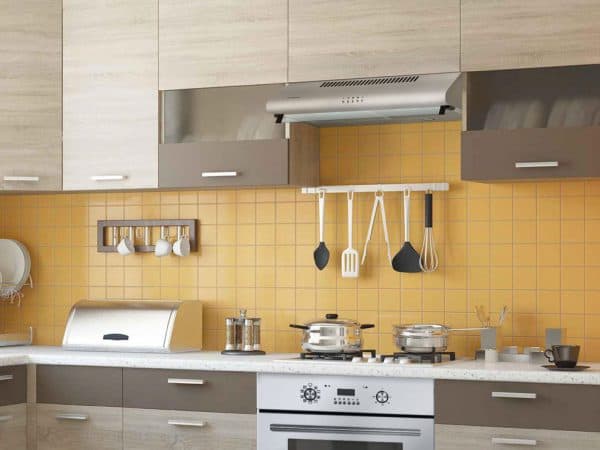
- Embedded.
- Dome.
- Corner.
- Island.

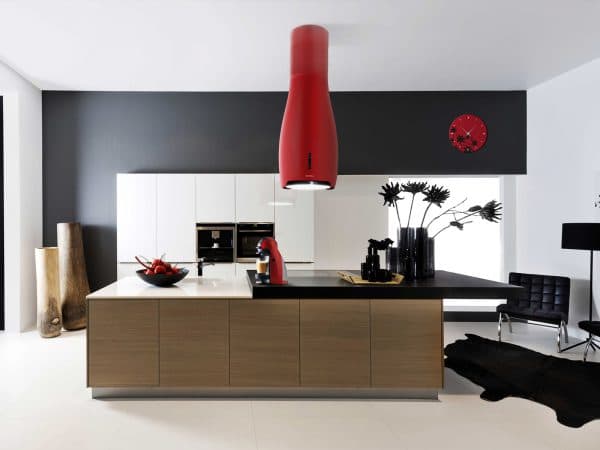
The island view is used if an island countertop is used.
- Suspended hoods - the most common and simple in design, therefore they are often called standard. They are attached directly above the slab to the wall. Such hoods are suitable for small kitchens (no more than 10 square meters), since they are not very powerful, but they work almost silently.
These are the most inexpensive models:
- Built-in retractors also belong to the inexpensive segment, but if the suspended hoods are simply hung on the wall, then the built-in ones need a body in the form of a separate cabinet above the stove. These are compact devices, but they are slightly more efficient in performance than pendant ones. The standard apron height can be found here.

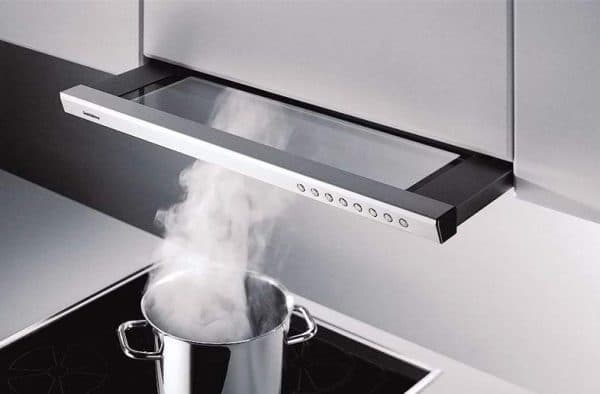
Built-in kitchen hoods are used in modern kitchens - Dome type hoods got their name from the shape of the case. These are dimensional hoods that take up a lot of space, but they also have the appropriate power.


Dome hoods for kitchens are used in very modern and made from natural materials kitchens - Corner hoods can also be domed or recessed. Their only difference is in the form. Such a hood is installed in a corner, but in fact, kitchens with a stove in the corner are very rare.
- Island hoods they are mounted above the stove, which is built into the “island” in the kitchen (a free-standing furniture module, as a rule, in the center of the kitchen). These are the most expensive hoods, as they are distinguished by their high performance, because if there is room for an “island” in the kitchen, then this is a very large kitchen.
Hood dimensions
The standard width of the factory kitchen models is 60, 90 or 120 cm. The size of the air cleaner must be the same or slightly larger than the size of the worktop. For a standard hob with a width of 60 cm, an exhaust unit with a width of 90 cm is perfect. Too large a model with a wide neck, should not be installed over a small-sized stove, the efficiency will not increase, but the noise level will significantly exceed the norm.
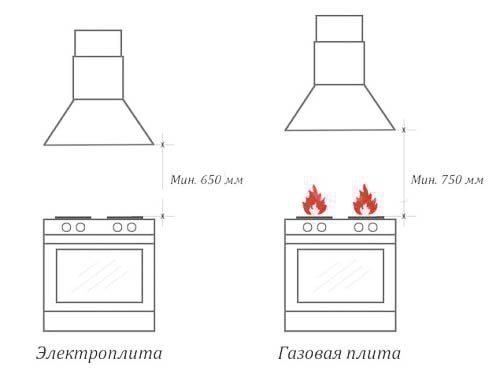

Diagram showing the required distance of the hood from the stove
Before buying an air purifier, keep in mind that according to the rules, it is installed at a distance of 70 cm above the electric stove, and 80 cm above the gas oven.
What are the hoods made of?
The cost and service life of exhaust equipment largely depends on what material it is made of.Manufacturers now make models from stainless steel, metal alloys, aluminum, glass and plastic. Plastic and metal alloy are considered to be the cheapest materials.
Plastic can be more or less durable, depending on the cost. Plastic models are easy to clean and do not rust. The plastic air purifier looks simple and strict. Plastic hoods are usually built-in hoods.
A hood with an aluminum casing is the best option. Aluminum is of high quality and inexpensive. These hoods do not rust, are easy to clean and fit any interior.
The elegant and expensive air purifiers are available in stainless steel or solid glass. Such a stainless steel model works for a long period of time, so it is better to pay more and enjoy the beauty for a long time.
Hood control and operation nuances.
Modern manufacturers complete products with various control methods. The existence of slide, push-button and sensor systems for controlling the operation of the hood is noted. The push-button appearance is characterized by simplicity and convenience, since the setting is done on the front panel. Slider controls are located at the bottom. In the hood with a touch panel, the buttons are built-in, and are illuminated from the inside. Such models look aesthetically pleasing.
Some hoods are equipped with a display that shows operating parameters and presets. A clock and a timer are included in the package of some units, with their help, the start time of the hood operation is set, and the subsequent shutdown. The function of self-determination of the temperature and humidity level and giving a signal to turn on the device provides convenience. The device, with a price above 10,000 rubles, is complemented by a remote control and the ability to independently set the required operating mode, choosing the desired fan speed depending on the amount of vapor.
To comply with safety precautions, the hood must be grounded, since, with a voltage surge, the motor or electronic control unit may burn out.
Air cleaner efficiency
The efficiency of the equipment is determined by calculating its performance. The capacity of an air cleaner is the volume of air processed per unit of time. The parameter is measured in cubic meters per hour.
The modern market offers models with a capacity range of 200-1000 cubic meters per hour.
To calculate the required performance of the equipment, you need to know the volume of air in the kitchen. The volume of a room is calculated by multiplying the length, width and height by each other. If they cook a lot and often in the kitchen, and also smoke, then the productivity should be greater than the calculated 200 cubic meters per hour. The performance of modern models can be adjusted independently depending on the needs.
Kitchen ventilation systems: natural or forced
Not everyone knows which ventilation scheme for the kitchen is better, the standard natural one, when exhaust gases go out through the channel to the street or forced (a fan is used to remove contaminated oxygen). There is no unequivocal answer to this question, because each of the hoods performs its functions, has its own advantages and disadvantages.
In the kitchen, regardless of its location (in an apartment or a private house), a natural ventilation system is required. Particular attention should be paid to the operability of the equipment, and especially if there is a gas stove in the room. In this case, harmful emissions will be discharged to the outlet through the vertical channel of natural ventilation. The exhaust rules do not consider forced ventilation as a mandatory engineering communication, it only provides the comfort of the residents. Next, we will describe each of the types of air exchange in more detail, consider their strengths and weaknesses.
Natural ventilation in the kitchen
Exhaust ventilation in the kitchen is familiar to all residents through vertical shafts that have an exit on the roof of a residential building. Harmful substances and vapors are removed through such passages, and fresh air enters the premises through cracks in the windows or special valves on the frames. Warm air heated by the stove rises upward, it accumulates on the ceiling and goes out through the ventilation hole outside the house. In its place comes fresh oxygen from the street.
Correct, well-installed ventilation for the kitchen in the apartment removes a small amount of waste gas, but it does so in a constant mode. The ventilation duct cleared of debris is able to remove carbon monoxide and minor fuel leaks from kitchen equipment. For high-quality removal of foreign odors, an extractor hood should be installed above the stove.
Supply ventilation has the following advantages:
- high-quality air exchange in the apartment;
- removal of harmful substances that are released during cooking;
- removal of odors and high humidity when several burners are turned on;
- lack of financial investments for the operation of the system;
- noiselessness.
Ventilation in a kitchen with a cooker hood has the following disadvantages:
- decrease in work efficiency in the presence of hot weather;
- the possibility of a return flow of air from the street to the kitchen;
- relatively small volume of processed air per unit of time;
- you need to constantly check the draft in the ventilation duct.
Not all owners of suburban real estate know how to properly arrange a natural ventilation system in a private house. In this case, the channels will be made in the walls of utility rooms such as bathroom, toilet and kitchen. For high-quality ventilation of the whole house, and not just these rooms, it is necessary to additionally let the air flow from the bedroom, living room or dining room. In some cases it is necessary to keep the windows open.
If a four-burner gas stove is installed in the kitchen, then the hourly volume of the processed air should be within 90m3. For efficient operation of the ventilation system, it is necessary to install a duct with a cross section of 0.02 m2. This parameter corresponds to a pipe diameter of 16 centimeters or a shaft made of bricks in the shape of a square with a side size of 14 centimeters. The entrance to the channel is located on the ceiling or at a distance of 20-30 centimeters from it. To ensure stable draft, a ventilation duct with a length of 5 meters or more is required.
Additional features of the hoods
To improve the convenience of users, manufacturers have equipped the equipment with additional useful functions.
- Intelligent equipment control system. It provides an automatic increase in productivity in the event of an increase in the intensity of the work of the plate.
- Backlight. Provides additional illumination of the slab space. For backlighting, halogen or fluorescent lamps are used, less often conventional incandescent lamps.
- Filter clogging indicators. Filter cleanliness is key to circulating models. It is not always convenient to monitor this on your own, so such indicators are very useful.
- Interval inclusion. It provides round-the-clock air circulation. Special sensors turn on the equipment at low power once every hour.
To clean the atmosphere of the kitchen from pollution and keep the inhabitants of the apartment healthy, an extractor hood is needed. The market offers a large selection of hoods for every taste and budget. The most important thing is to understand exactly what such equipment is needed for, how it works in the kitchen, and what parameters will help to make the right choice of equipment.
How the cooker hood works


All types of cooker hoods are based on the same operating principle: capture and discharge of exhaust air. However, according to the method of performing this task, the hoods are divided into 3 types:
- Flow-through hood. The principle of operation of such a hood is to take in polluted air and remove it outside the room. Air is removed through ventilation. The advantages of a flow hood are reliability and durability, minus - the necessary access to fresh air (ventilation with an open window) and additional adapters for pipes in old houses.


- Recirculation hood. Such an exhaust hood cleans the exhaust air using a filtration system, and then returns it back to the room. Recirculation models are easy to install, their cost is lower than flow-through ones, but the disadvantages include the need to regularly replace carbon filters.
- Combined cooker hood. Combines the principles of both options. The peculiarity of the installation of the combined hood in planning during the renovation. Installing the hood for a finished repair will not work without damage.
The main component in a cooker hood is a filter.
It is advised to include one or a couple of the following types of filters in the complete set of hoods:
Carbon filters are disposable, designed to collect small particles and neutralize odors. There are disposable filters made of paper, non-woven or padding polyester. Filter that collects greasy particles. They are classified as disposable, made of synthetic fabric, and reusable, made of multiple layers of aluminum mesh.
These filters do not require replacement and can be cleaned with conventional detergents. Filters made from acrylic are also considered reusable. If heavily soiled, they are washed in warm water with a detergent. But, in no case, do not squeeze, damage the structure.
Advice.
The charcoal filters should be replaced at least every six months. But there are models that require a change only after a year of use. If the hood is switched off five minutes after cooking, the frequency of filter changes will be reduced. This procedure is carried out independently, since it does not mean anything difficult by itself.
Types of kitchen hood


First of all, when choosing a kitchen hood, pay attention to the appearance. Depending on the design, there are several types of kitchen hoods.
- Built-in hood. Installed in a kitchen cabinet above the hob, so the hood is almost invisible from the outside. The inside of the cabinet is connected to ventilation. Low noise level and aesthetically pleasing appearance make this model the most popular among buyers. The pull-out hood increases the surface area to be covered and retracts back after the end of cooking.


- Suspended hood. The traditional version is located above the hob at the bottom of the kitchen cabinet. Takes up little space, easy to install, does not require a call of specialists for installation. It works on the principle of air recirculation, the low starting cost is paid off by purchasing expensive carbon filters.
- Dome hood. This technique is part of the stylistic interior design. Externally, the hood looks like a chimney pipe, takes up a lot of space, so it is not suitable for a small-sized kitchen. The range of dome hoods is wide; there is a suitable option for any style. The price range will delight every buyer.


- Island hood. A type of domed hood, installed in a kitchen with a working area placed in the center of the room. This layout is called island. The hood, located in the center of the room, has more power and, accordingly, dimensions.
- Domino hood. A modern type of hood, mounted directly behind the stove in the work surface.During cooking, the hood moves upward, perpendicular to the stove. The disadvantage of this design is the high cost. In addition, for a large kitchen, it is safer to choose a more powerful and voluminous option.
Hood width, noise level and lighting methods.
One of the fundamental parameters when choosing a hood will be width. There are three common sizes: 50, 60 and 90 centimeters and many in between, which are typical for built-in models. Fifty-centimeter hoods are ideal for a small kitchen. In terms of efficiency, they are not inferior to the rest, differ in size and cost.
Noise level data can be found in the technical data sheet of the product or check with the specialists serving such equipment. It is worth choosing a device with the lowest noise level. Take the figure of 40 decibels as a reference point, it is characterized by a muffled sound.
For additional lighting of the hob, incandescent, daylight or halogen lamps are used. Hoods with halogen backlighting have a higher cost, but are characterized by economy in energy consumption. Additional lighting is installed in front or behind the exhaust panel.
The subtleties of choosing a kitchen hood


Before buying a kitchen hood, you need to decide on the size and type of future technology. In addition to these parameters, pay attention to the other technical characteristics of the hood.
- The capacity of the hood is measured in cubic meters per hour and determines the amount of processed air per hour. Calculate the required performance for a specific kitchen using a special formula, based on the data obtained, select the hood model.
- Find out about the type of hood filters used in this model. Coarse filters, presented in the form of a metal mesh, are available in all hoods. Clean the filter mechanically as it gets dirty. But the carbon filters for the recirculation hood will have to be purchased separately, they cannot be cleaned, only replaced.
- The hood can be controlled by touch, push-button or remote control.
- The hoods are equipped with useful additional functions. For example, lighting or the ability to set the operating interval for constant fresh air access.
It is not difficult to choose the right range hood for your kitchen. The cooker hood will get rid of annoying odors, help keep the kitchen clean and extend the service life of new renovations in the apartment.
23 august 2017
Selection recommendations
Before choosing a hood, pay attention to its dimensions, operating modes, functionality, ease of operation, types of filters.
The main thing is that the dimensions of the hood exceed the dimensions of the hob or stove. The best ratio would be a 25-30% excess. This will make it possible to efficiently and efficiently capture and clean air flows.
The correct selection of the hood should ensure 100% cleaning efficiency. An important parameter, on which the performance of the device directly depends, is the force of the pressure of the ascending flow of the drawn in air created by the electric fan.
During normal operation, the extractor motor must be loaded to no more than 50% of its power, so that in emergency situations the extractor hood can provide air purification with maximum efficiency. Best of all, if the capabilities of the device will be twice the required for a given kitchen space.
Good appliances usually have not one, but two electric motors, which ensures the functionality of the hood with a minimum noise level. As you know, excessive noise exceeding the comfort threshold (up to 40 dB) with a sufficiently long exposure can have a depressing, rather harmful effect on the human psyche.
Many modern hoods have several operating modes: hood (removal of contaminated air from the room), cleaning (suction and filtration). Therefore, when purchasing, you must carefully read the technical description, type and characteristics of the device. Since the exhaust mode in the absence of a ventilation duct in your kitchen is unlikely to be needed and you should not overpay for it.


How the cooker hood works
All types of cooker hoods are based on the same operating principle: capture and discharge of exhaust air. However, according to the method of performing this task, the hoods are divided into 3 types:
- Flow-through hood. The principle of operation of such a hood is to take in polluted air and remove it outside the room. Air is removed through ventilation. The advantages of a flow hood are reliability and durability, minus - the necessary access to fresh air (ventilation with an open window) and additional adapters for pipes in old houses.
- Recirculation hood. Such an exhaust hood cleans the exhaust air using a filtration system, and then returns it back to the room. Recirculation models are easy to install, their cost is lower than flow-through ones, but the disadvantages include the need to regularly replace carbon filters.
- Combined cooker hood. Combines the principles of both options. The peculiarity of the installation of the combined hood in planning during the renovation. Installing the hood for a finished repair will not work without damage.
The main types of hoods
The choice of hoods for the kitchen is primarily based on the type of hood. Among them, the following types are distinguished, which have their own characteristics and patterns of operation:
- Recirculating;
- Flowing;
- Combined.
In turn, each type is used for its intended purpose and meets the requirements of the buyer. Much attention should be paid to this issue, because factors such as the complexity of installation, performance and practicality will depend on the choice of the type of hood.
And now you should consider in detail each of the types and determine why each type is better suited for certain operating conditions.
Recirculating
The recirculating type of hood is a common choice of people. The principle of operation consists in the following actions: The fans draw in the air, which passes through the cleaning with a carbon filter and again enters the room through the grill.
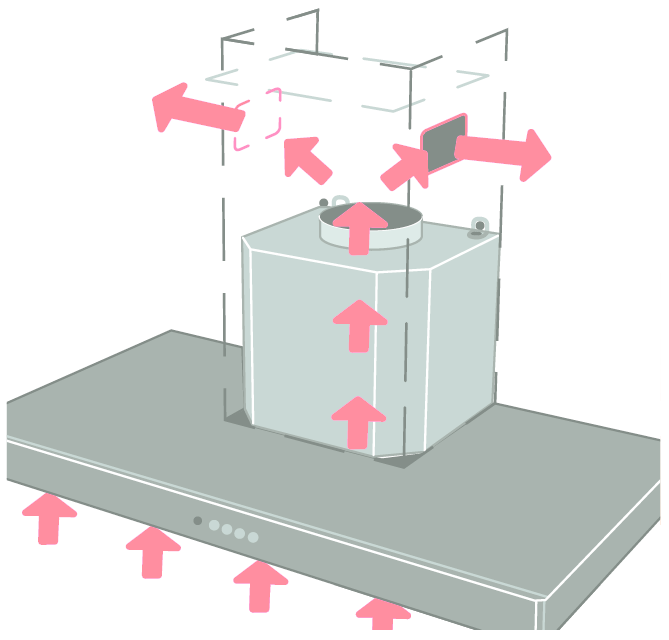

Recirculation hood
Recirculation hoods are easy to install, because there is no need to install pipes to connect the hood to the ventilation duct. Another advantage of this choice is that in winter warm air does not leave the room, as in a flow-through system.
The disadvantage of this choice is that this type of exhaust system is not efficient. It is able to work with less air volume per hour than flow hoods. However, this is also a plus if you put energy savings first.
It should be noted that the owner of the recirculation hood needs to regularly replace the carbon filter. Over time, it becomes clogged with fat and other waste, so the air returns to the room with the same content as when it was absorbed.
Owners of private houses without ventilation ducts can safely give preference to this option, because it is expensive and time-consuming to develop and install ventilation ducts.
Flowing
Flow hoods are not inferior in popularity to their competitor, the recirculation type. The principle of operation is as follows: due to the operation of several fans, air is sucked in and enters the ventilation duct, where it is directed directly outside the house.
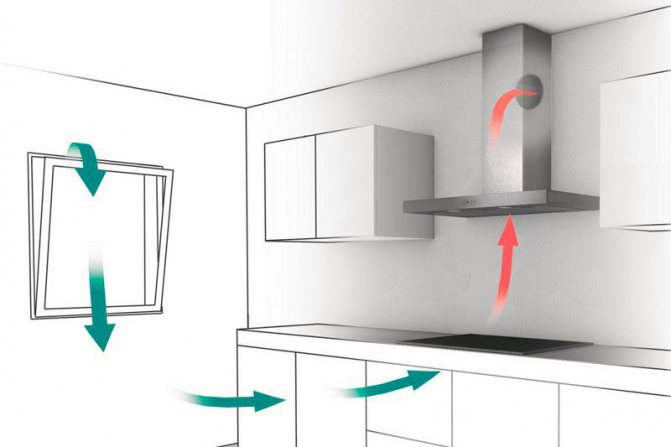

Flow-through hood
Installation of flow through hoods is slightly different from the above type.In addition to connecting to the electricity network, the master must connect the device to the ventilation duct. As a result, a flow-through hood to the kitchen takes both time and money.
One feature of this type of equipment should be noted. When the exhaust air leaves the room, fresh outside air enters the room due to the pressure difference. On the one hand, in the summer, for example, the kitchen will constantly be saturated with oxygen. However, in winter, already cold air will enter the room, which entails large heat losses in the entire apartment or house.
This option is suitable for apartment owners in multi-storey buildings, where ventilation ducts have already been thought out and installed. Also, it is the flow hoods for the kitchen that have the highest performance among others, therefore, a large volume of air per hour will be worked out.
Combined
Combined hoods for the kitchen are called universal - they can work both in flow and recirculation mode. This option is used by those people who cannot decide on the previous types of exhaust systems. It should be noted that the choice is the most correct.
At any time, the user can set the flow mode. In this case, all the air will go outside the room, and fresh air will saturate the air with oxygen. For example, during prolonged frying or steaming, you can use this particular mode.
The recirculation mode can be safely switched on with gentle cooking modes. In winter, warm air will not leave the premises, so heat loss will be minimal.
If it speaks about productivity, then it will be practically the same, both in recirculation mode and in flow mode. Electricity consumption does not depend on the mode.
Installation must meet the needs of each mode: piping must be installed to connect the hood to the ventilation duct. In combination devices, charcoal filters are already installed, but they must be replaced regularly.
It doesn't matter where to install such a device: in an apartment or in a private house. Choosing a mode, a person adjusts the equipment to suit his needs and determines the level of performance. Most importantly, the ability to independently decide how to dispose of the exhaust air allows you to regulate energy and heat costs.


Types of kitchen hood
First of all, when choosing a kitchen hood, pay attention to the appearance. Depending on the design, there are several types of kitchen hoods.
- Built-in hood. Installed in a kitchen cabinet above the hob, so the hood is almost invisible from the outside. The inside of the cabinet is connected to ventilation. Low noise level and aesthetically pleasing appearance make this model the most popular among buyers. The pull-out hood increases the surface area to be covered and retracts back after the end of cooking.
- Suspended hood. The traditional version is located above the hob at the bottom of the kitchen cabinet. Takes up little space, easy to install, does not require a call of specialists for installation. It works on the principle of air recirculation, the low starting cost is paid off by purchasing expensive carbon filters.
- Dome hood. This technique is part of the stylistic interior design. Externally, the hood looks like a chimney pipe, takes up a lot of space, so it is not suitable for a small-sized kitchen. The range of dome hoods is wide; there is a suitable option for any style. The price range will delight every buyer.
- Island hood. A type of domed hood, installed in a kitchen with a working area placed in the center of the room.This layout is called island. The hood, located in the center of the room, has more power and, accordingly, dimensions.
- Domino hood. A modern type of hood, mounted directly behind the stove in the work surface. During cooking, the hood moves upward, perpendicular to the stove. The disadvantage of this design is the high cost. In addition, for a large kitchen, it is safer to choose a more powerful and voluminous option.
Recirculation hood classification.
To satisfy the desires and preferences of the buyer, to choose a hood for any interior and wallet, there are various classes of such devices:
- Inclined
- Flat
- Embedded
- Dome
- Corner
Inclined hoods are attached to the wall at an angle, which helps to free up more space above the stove. Due to their functionality and compactness, devices with such a device are the most popular.
Flat, are hinged hoods. They are mounted on the wall or attached to the cabinet above the hob. The creators of such devices use reusable filters made of aluminum. Attachment motors are characterized by a low power level.
Built-in hoods are mounted in a wall cabinet. These devices are equipped with a pull-out panel that increases the air suction width. The complete set contains two motors, due to which there is an increase in the performance of the hood, washable metal filters.
The installation of the dome hood takes place directly to the wall of the room. In shape, it resembles a fireplace or a dome. In appearance, they are classified into all-metal, metal with the addition of glass or wood for decoration, and only wood-trimmed device types.
The difference between corner hoods lies in the design of the housing, which facilitates the device in the corner of the room.
The subtleties of choosing a kitchen hood
Before buying a kitchen hood, you need to decide on the size and type of future technology. In addition to these parameters, pay attention to the other technical characteristics of the hood.
- The capacity of the hood is measured in cubic meters per hour and determines the amount of processed air per hour. Calculate the required performance for a specific kitchen using a special formula, based on the data obtained, select the hood model.
- Find out about the type of hood filters used in this model. Coarse filters, presented in the form of a metal mesh, are available in all hoods. Clean the filter mechanically as it gets dirty. But the carbon filters for the recirculation hood will have to be purchased separately, they cannot be cleaned, only replaced.
- The hood can be controlled by touch, push-button or remote control.
- The hoods are equipped with useful additional functions. For example, lighting or the ability to set the operating interval for constant fresh air access.
It is not difficult to choose the right range hood for your kitchen. The cooker hood will get rid of annoying odors, help keep the kitchen clean and extend the service life of new renovations in the apartment.
Post Views: 26
Hood functions in the kitchen
The hood, which can be seen in any kitchen, is a simple device, and regardless of the price and the number of "bells and whistles", all hoods have one principle of operation.
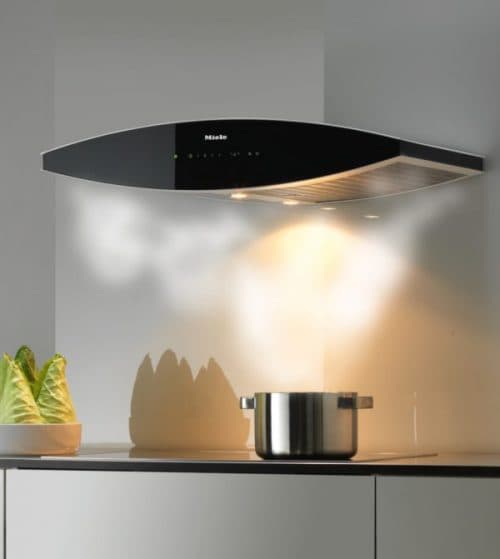

Hood operation in the kitchen
The hood consists of the following elements:
- Metal body;
- An engine that takes in the air flow (in some models there may be two of them);
- Filters that purify the incoming air;
- A lamp that serves to illuminate the workplace.
According to statistics, women spend in the kitchen cooking more than half of the time during which they are at home. And since the air in the kitchen, containing particles of fat and harmful combustion products, negatively affects health, a hood is simply necessary.
The hood will not help completely get rid of foreign impurities and odors, but without it the situation would be catastrophic, and those who happened to grow up in Soviet apartments may remember that the whole entrance knew when neighbors from the first floor were frying fish. Many nuances should be thought out in the kitchen for convenience, this also applies to water-saving tap nozzles, which can be found here.
The video shows the functions of the hood in the kitchen:
Please note: it is believed that in modern apartments, supply and exhaust ventilation is designed to clean the air by drawing it into the ventilation shaft. In practice, this does not happen, since the mines very quickly become clogged with dirt and dust, therefore the hood is the most effective way to remove particles of burning and harmful substances. By the way, the corrugated pipe outlet of the hood also removes air into the same shaft, but due to strong injection. It is also necessary to select the correct air duct for the hood.
But the hood, regardless of the cost, will not work efficiently if its capacity is not enough to work in a room of a certain size. In order not to be mistaken when choosing, you can independently calculate how much power is enough for your kitchen.
There is a formula for this:
Q = 12xSxH
H - kitchen height in meters
S - kitchen area
12 is a coefficient indicating that the air in the room must be completely renewed 12 times within one hour (according to sanitary standards).
Multiplying these numbers, you get the number Q: this is the amount of cubic meters of air that must be renewed in your kitchen in one hour. Among the characteristics of each hood, this parameter is indicated, and if Q is equal to or greater than according to your calculations on the device you like, you can buy. But the reviews about such a meat grinder as Mulinex can be found in this article.
